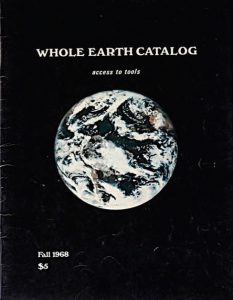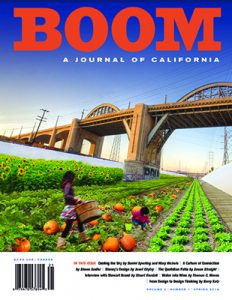 Simon Sadler, PhD, a member of the arcCA DIGEST editorial board, teaches the history and theory of architecture, design, and urbanism in the Department of Design and the Program in Art History at UC Davis. Among his many publications are several exploring “the intimate, underanalyzed relationship between California and the very idea of design,” as he puts it in “A Culture of Connection: How Design Makes Us All Californian.”
Simon Sadler, PhD, a member of the arcCA DIGEST editorial board, teaches the history and theory of architecture, design, and urbanism in the Department of Design and the Program in Art History at UC Davis. Among his many publications are several exploring “the intimate, underanalyzed relationship between California and the very idea of design,” as he puts it in “A Culture of Connection: How Design Makes Us All Californian.”
Why direct readers to this article in a season of arcCA DIGEST devoted to the topic of “Data”? This passage provides a clue:
 [O]ne oddity of the Californian project was that it short-circuited the dialectic between nature and technology, such that technology was not even mediating between nature and culture, but merged with them into a single, designed assembly. This vision of California was briefly de facto governmental policy when [Stewart] Brand became an advisor to the state governor Jerry Brown during his first period in office from 1975–83, and when another of the [Whole Earth] Catalog’s editors, Sim van der Ryn, became State Architect. Van der Ryn named the principal state building constructed during his tenure—Sacramento’s Bateson Building (1977–81), a stand-out early ecological design—for Brand’s mentor, the anthropologist Gregory Bateson.
[O]ne oddity of the Californian project was that it short-circuited the dialectic between nature and technology, such that technology was not even mediating between nature and culture, but merged with them into a single, designed assembly. This vision of California was briefly de facto governmental policy when [Stewart] Brand became an advisor to the state governor Jerry Brown during his first period in office from 1975–83, and when another of the [Whole Earth] Catalog’s editors, Sim van der Ryn, became State Architect. Van der Ryn named the principal state building constructed during his tenure—Sacramento’s Bateson Building (1977–81), a stand-out early ecological design—for Brand’s mentor, the anthropologist Gregory Bateson.
A Californian of British extraction, Bateson advocated the possibility that human and non-human assemblies (like whole regions) could think as singular cybernetic minds.
 “A Culture of Connection” appeared in the Spring 2012 issue of BOOM: A Journal of California, which was published by the University of California Press from 2011 to 2016. Its successor is BOOM California, “a free refereed online media publication dedicated to inspiring lively and significant conversations about the vital social and cultural issues of our time in California and the world beyond . . . in the forms of peer reviewed articles that both highlight and advance scholarly discourse about California culture, and do so in a manner that is public-facing and oriented toward the social and practical concerns of ordinary Californians.”
“A Culture of Connection” appeared in the Spring 2012 issue of BOOM: A Journal of California, which was published by the University of California Press from 2011 to 2016. Its successor is BOOM California, “a free refereed online media publication dedicated to inspiring lively and significant conversations about the vital social and cultural issues of our time in California and the world beyond . . . in the forms of peer reviewed articles that both highlight and advance scholarly discourse about California culture, and do so in a manner that is public-facing and oriented toward the social and practical concerns of ordinary Californians.”
From arcCA DIGEST Season 4, “Data.”





